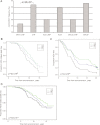Multiple-cohort genetic association study reveals CXCR6 as a new chemokine receptor involved in long-term nonprogression to AIDS
- PMID: 20704485
- PMCID: PMC3601691
- DOI: 10.1086/655782
Multiple-cohort genetic association study reveals CXCR6 as a new chemokine receptor involved in long-term nonprogression to AIDS
Abstract
Background: The compilation of previous genomewide association studies of AIDS shows a major polymorphism in the HCP5 gene associated with both control of the viral load and long-term nonprogression (LTNP) to AIDS.
Methods: To look for genetic variants that affect LTNP without necessary control of the viral load, we reanalyzed the genomewide data of the unique LTNP Genomics of Resistance to Immunodeficiency Virus (GRIV) cohort by excluding "elite controller" patients, who were controlling the viral load at very low levels (<100 copies/mL).
Results: The rs2234358 polymorphism in the CXCR6 gene was the strongest signal (P=2.5 x 10(-7); odds ratio, 1.85) obtained for the genomewide association study comparing the 186 GRIV LTNPs who were not elite controllers with 697 uninfected control subjects. This association was replicated in 3 additional independent European studies, reaching genomewide significance of P(combined)=9.7 x 10(-10). This association with LTNP is independent of the CCR2-CCR5 locus and the HCP5 polymorphisms.
Conclusions: The statistical significance, the replication, and the magnitude of the association demonstrate that CXCR6 is likely involved in the molecular etiology of AIDS and, in particular, in LTNP, emphasizing the power of extreme-phenotype cohorts. CXCR6 is a chemokine receptor that is known as a minor coreceptor in human immunodeficiency virus type 1 infection but could participate in disease progression through its role as a mediator of inflammation.
Conflict of interest statement
Potential conflicts of interest: none reported.
Figures


Similar articles
-
Role of exonic variation in chemokine receptor genes on AIDS: CCRL2 F167Y association with pneumocystis pneumonia.PLoS Genet. 2011 Oct;7(10):e1002328. doi: 10.1371/journal.pgen.1002328. Epub 2011 Oct 27. PLoS Genet. 2011. PMID: 22046140 Free PMC article.
-
Distinctive effects of CCR5, CCR2, and SDF1 genetic polymorphisms in AIDS progression.J Acquir Immune Defic Syndr Hum Retrovirol. 1998 Dec 1;19(4):381-6. doi: 10.1097/00042560-199812010-00009. J Acquir Immune Defic Syndr Hum Retrovirol. 1998. PMID: 9833747
-
CXCR6 gene characterization in two ethnically distinct South African populations and association with viraemic disease control in HIV-1-infected black South African individuals.Clin Immunol. 2017 Jul;180:69-79. doi: 10.1016/j.clim.2017.04.006. Epub 2017 Apr 18. Clin Immunol. 2017. PMID: 28428094 Free PMC article.
-
[Anti-HIV-1 genes; genetic restriction of AIDS pathogenesis by gene variants].Nihon Rinsho. 1999 Apr;57(4):967-74. Nihon Rinsho. 1999. PMID: 10222798 Review. Japanese.
-
Considering genetic profiles in functional studies of immune responsiveness to HIV-1.Immunol Lett. 2001 Nov 1;79(1-2):131-40. doi: 10.1016/s0165-2478(01)00275-9. Immunol Lett. 2001. PMID: 11595300 Review.
Cited by
-
Host genomic influences on HIV/AIDS.Genome Biol. 2013 Jan 31;14(1):201. doi: 10.1186/gb-2013-14-1-201. Genome Biol. 2013. PMID: 23369251 Free PMC article. Review.
-
Genome-wide association studies on HIV susceptibility, pathogenesis and pharmacogenomics.Retrovirology. 2012 Aug 24;9:70. doi: 10.1186/1742-4690-9-70. Retrovirology. 2012. PMID: 22920050 Free PMC article. Review.
-
Effect of antiretroviral therapy on the mortality of HIV-1 infection long-term non-progressors: a cohort study.BMC Infect Dis. 2025 Jan 16;25(1):72. doi: 10.1186/s12879-025-10448-x. BMC Infect Dis. 2025. PMID: 39819447 Free PMC article.
-
Multicohort genomewide association study reveals a new signal of protection against HIV-1 acquisition.J Infect Dis. 2012 Apr 1;205(7):1155-62. doi: 10.1093/infdis/jis028. Epub 2012 Feb 23. J Infect Dis. 2012. PMID: 22362864 Free PMC article.
-
Role of exonic variation in chemokine receptor genes on AIDS: CCRL2 F167Y association with pneumocystis pneumonia.PLoS Genet. 2011 Oct;7(10):e1002328. doi: 10.1371/journal.pgen.1002328. Epub 2011 Oct 27. PLoS Genet. 2011. PMID: 22046140 Free PMC article.
References
-
- Limou S, Le Clerc S, Coulonges C, et al. Genomewide association study of an AIDS-nonprogression cohort emphasizes the role played by HLA genes (ANRS Genomewide Association Study 02) J Infect Dis. 2009;199:419–426. - PubMed
-
- Grabar S, Selinger-Leneman H, Abgrall S, Pialoux G, Weiss L, Costagliola D. Prevalence and comparative characteristics of long-term nonprogressors and HIV controller patients in the French Hospital Database on HIV. AIDS. 2009;23:1163–1169. - PubMed
-
- Huber C, Pons O, Hendel H, et al. Genomic studies in AIDS: problems and answers. Development of a statistical model integrating both longitudinal cohort studies and transversal observations of extreme cases. Biomed Pharmacother. 2003;57:25–33. - PubMed
Publication types
MeSH terms
Substances
Grants and funding
LinkOut - more resources
Full Text Sources
Other Literature Sources
Medical

